Panzerträgerwagen ATG-7
 Germany - c40 made 1942-44.
Germany - c40 made 1942-44.
An introduction: The BP-44 Armoured Train
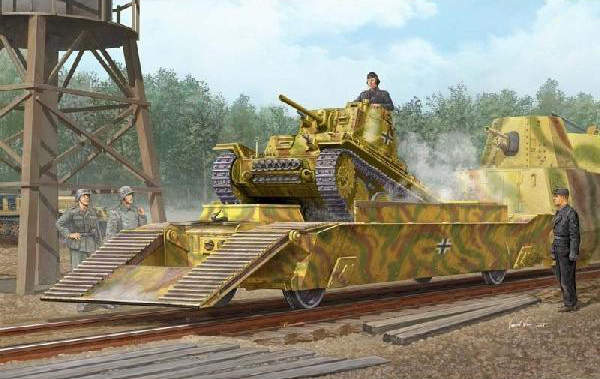
The BP42 was an armoured train consisting of around 130 soldiers, symmetrical in composition. In the middle was the armored locomotive protected further by an armored tender front and rear. The half-trains were composed on each side, of a gun carriage, and infantry or command vehicle, one artillery and anti-aircraft vehicle, and armored carrier vehicle (generally Panzer 38 (t)) and a heavy combat vehicle.
The BP44 was introduced in 1944 as a reinforced version of the BP42, the class generated a serie, from armored train No.73 to 84. PZ83 and PZ84 cars were discarded, and the most striking change was the addition of a Panzerjägerwagen we already covered here. Not all BP42s could be retrofitted with it as it was in scarce availability. The retrofitting of the old gun carriage with a 10.5cm or a 15cm field howitzer was also a difference. BP42 and BP44 platoons were also preceded by two Schienenpanzer 204(f) or Panhard armored reconnaissance vehicles.
Standardization of armored platoons could not be maintained and numerous sub-variants appeared aggravated by material shortages. Notably the Flalvierling units were replaced by simpler Wirbelwind turrets. The railway armored train 26 had two T34 turrets in 1944 on a railcar. Armored train 27 carried two medium Somua S35 tanks on modified flatbeds. In 1943, Saurer works in Vienna commissioned a dedicated rail chassis to mount the Panzer III but production never started as the type was obsolete by then.
BP42/BP44 armored trains were assigned supply trains with a living and supply section, 1-2 officers caravans, 6-10 crew caravans, former express trains and passenger cars. In 1944 these were only enclosed freight cars. The supply section comprised a weapons and workshop car, a clothing car, an ammunition car, a catering car, a construction and equipment car and two utility flat cars to mount wheeled vehicles of the supply train (VW kübelwagen) and were affected locomotives depending on availability.
About the Panzerträgerwagen ATG-7
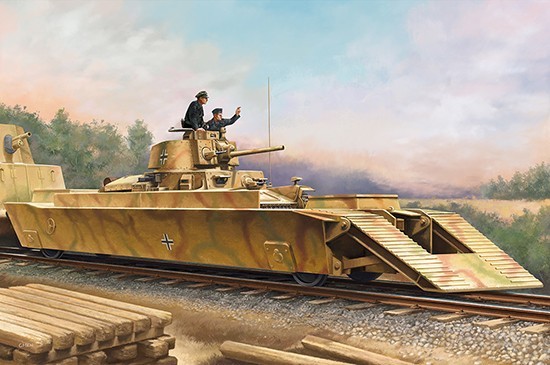
This was essentially a tailored, armoured flatcar with high sides and ramps to facilitate the transport and delivery of an armoured vehicle. A version existed already for the BP42 allowing to carry a Panzer 38(t) light tank for autonomous operations around the train. But in time, more vehicles were carried, such as the Somua S.35 and one exceptionallly carried in 1942 the unique 12.2 cm FK(r) auf Geschützwagen Lorraine Schlepper(f).
The armament of the BP-42 already consisted of 2 tanks, helping to bring combat out of the train on the open. These needed to be transported, and this was done with the Panzerträgerwagen type ATG-7 transport open railway car. They were carried and stored in such a way that the chassis was protected from by its side armor plates, leaving only the upper armour emerge.
The fixed, but extensible ramp at the front allowed for quick loading and exiting. Light tanks LT-38 types were generally used for the BP-42 train, as they were now unsuitable for fighting medium and heavy types, especially on the Eastern Front, but proven and highly effective to deal with partisans with their 37 mm main gun and two light Besa machine guns.
Design
The design of the ATG-7 was peculiar. There was an alternative variant which was a flatcat on which the tank sat on the flatbed, with sides protected by flat armour panels with intermediary reinforcements. The tank, a captured Somua S.35 was protected by these sides. However to unload it, the flatcar was provided by ramps, folded up when not in use. There was another version for the Panzer 38(t) (photo here) with forward and rear flat ramps with hinges and a central "bucket" in which sat the Panzer 38(t), down to half the drivetrain. The sides were protected by light plating. It seems that model was the ATG-7 already on the BMP-42.From a two-axle flatcar, the ATG-7 was a brand new design, combining a slightly deeper "bucket" in which sat the tank, and the original flatcar was inside a simple armoured structure which sourrounded the tank and presented sloped faces on all sides; A single ramp was located forward, with two ramps supported by arms, activated through power steering, provided by the train via electric connections or manual. Once the tank was inside, it was protected by an upper flat plating. The sides were sloped with downwards inverted plates, including forward and aft.
The armour was probably around 13 mm down to 8 mm to at least deflect antitank rifle fire. The large twin ramp (connected forward) was hinged on two levels. There was another fixed ramp inside and serrations for the tank tracks to rest into and stay stable. If need there was another of such ramp at the rear on which the tank can be raised as well. Folding panels could be raised there. The pushstops and connection hooks were protected by side armour as well. Large storage boxes were visible between serrated paths for storage. The ATG-7 had no independent drive. Another 5-side view of the ATG-7 with a Panzer 38(t).
About the 12.2 Fk(r) auf ATG-7
12.2cm FK(r) auf GW Lorraine Schleppe(f) was a singular self propelled howitzer, combining a Soviet 122 mm howitzer M1938 (M-30) integrated into an armoured casemate carried by a Lorraine-Schlepper tractor. Lorraine produced large quantities of its artillery supplier Lorraine 37L armored supply tractors, which were captured and often converted notably by the commando Becker, into armoured self propelled guns. The 12.2cm FK(r) auf GW Lorraine Schlepper(f) was a new type to provide organic heavy firepower to armoured trains. It was specifically design to be included on BP 44 trains.As a long range artillery gun designed to deliver high explosive HE shells great distances, once in place in its ATG-7 car, however its traverse was limited. To fire and more angles, the vehicle needed to be landed, which in turn, needed to decouple the forward car (if any) to free the ramp. It was done with an automatic Scharfenberg coupling. In general all photos shows the ramp side free. The vehicle most often was dismounted and used for indirect fire at targets plotted on a map. The vehicle was very similar to the 10.5cm leFH 18/40 auf GW Lorraine Schlepper(f) created bt Alkett. On photos though the ATG-7 was often coupled at the end of the train, freeing arc for the SPG to fire "mounted" underway or stopped in position. Indeed the train could use a track turn to acquire the right angle, like heavy artillery on rail did in WWI. In any case, only one donor vehicle was so converted, shown in all photos. It emerged in films and photos in 1942 and remained most likely alone.
Gallery

Camouflaged panzerträgerwagen with Panzer 38(t) 1943

Panzerträgerwagen with 12.2cm FK(r) auf GW Lorraine Schlepper(f)
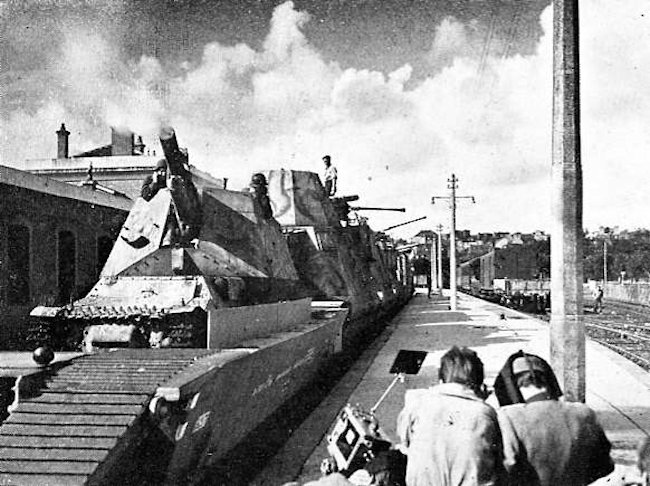
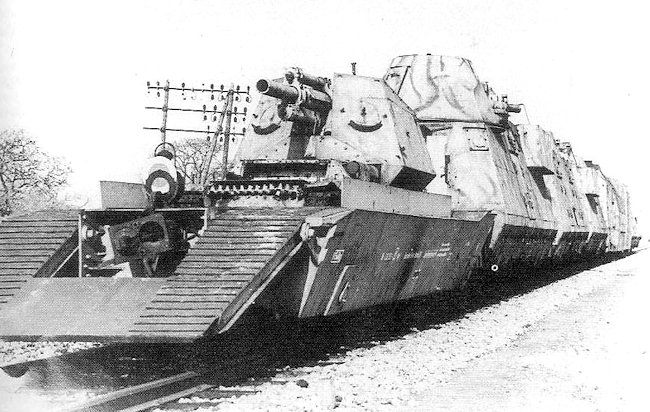
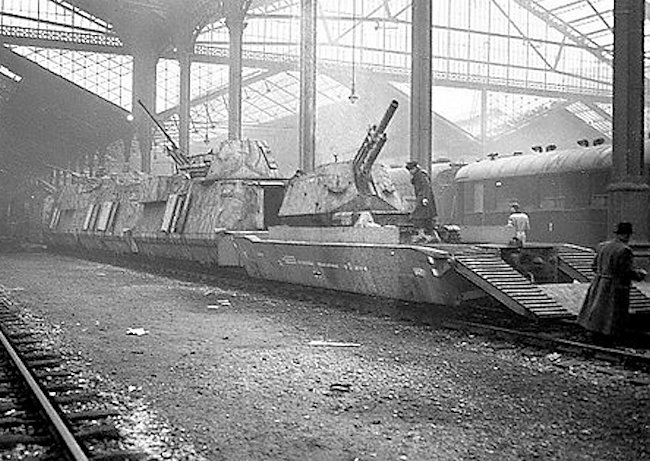
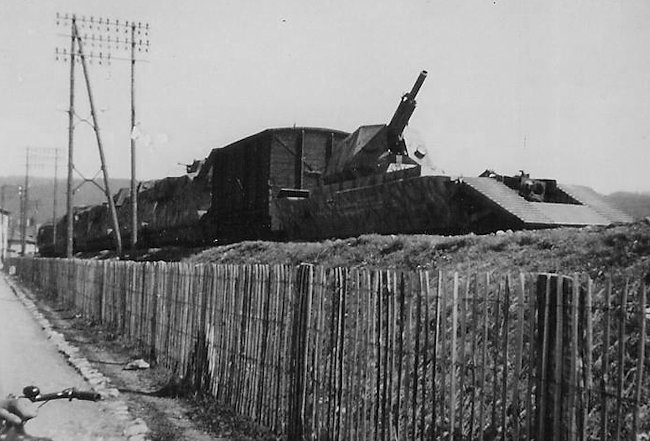
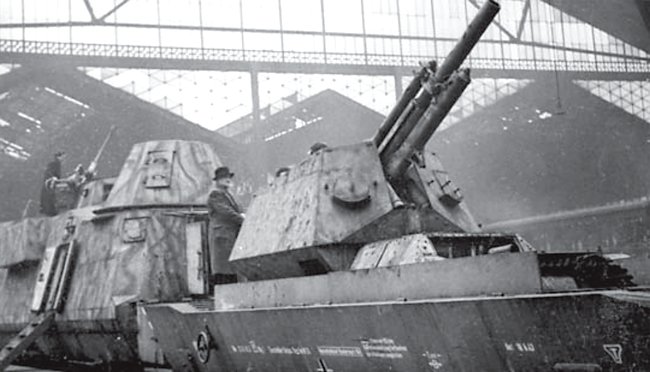

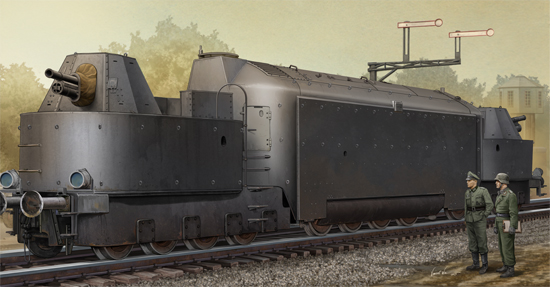
Sources/Read More
Armored Trains by Steven J Zalogakvhcarpathia.sk
tanks-encyclopedia.com
panzerbaer.de
- Baldwin Railroad battery 1861
- No 6 Garrison Arm. Train 1894
- Ladysmith Train 1899
- Crewe Works 1915 coastal train
- French mobile artillery battery (1914)
- Royal Navy armoured Train 1914
- Regia Marina Arm. Trains 1915-18
- Ajmer arm. trains 1916
- Hungarian MAVAG train
- German Panzerzug Ost (1916)
- Bolshevik Armored Tram 1917
- Finnish Arm. Train (1918)
- Zaamurets (Orlík, BP-4, Lenin)
- Khunkhuz
- General Annenkov
- Yenisei
- Amur
- Terek
- Don
- Dywizja Syberyjska trains 1918
- Kozak
- Piłsudczyk
- PP3
- Gromobój
- Pionier
- Śmiały
- Lis-Kula
- Hallerczyk
- Stefan Batory
- Generał Iwaszkiewicz
- Chrobry
- Wilk
- Danuta
- Poznańczyk
- Kaniów
- Zawisza Czarny
- Zagończyk
- Paderewski
- Mściciel
- Reduta Ordona
- Huragan
- Podhalanin
- Bartosz Głowacki
- Pierwszy Marszałek
- Groźny
- Śmierć
- Śmigły
- Stefan Czarniecki
- Generał Sosnkowski
- Putilov armoured trains
- Izhorskiy Armored Train
- Czechoslovak Legion Trains
- Estonian Trains
- Lithuanian Trains
- Zhang Zongchang Train
- Danuta
- Poznańczyk
- Generał Sosnkowski
- Paderewski
- Śmierć
- Pierwszy Marszałek
- Piłsudczyk
- Śmiały
- Groźny
- Bartosz Głowacki
- Smok Kaszubski
- Drezyna R
- Drezyna TK/TKS
- UK dywizjon Trains
- SOK Draisines 1945
- Arm. draisine Crochat
- Austro-Daimler Draisine
- Armoured draisine Tatra T18
- MBV-2 Rail cruiser
- D-2 Draisine (MBV-31)
- D-37 Draisines
- Krasnaja Zvezda (KZ-1)
- D-3 Draisines
- BTD heavy Draisines (5)
- CB-1 Draisines
- DT-45 Draisines
- BD-41 Draisines (12)
- BA-I-Zhd Railcar
- BA-6ZhD Railcar
- BA-20ZhD Railcar
- BA-10Zhd Railcar
- VS-60 Train/Wagon
- BP-35L/H Train
- NKPS-42/Wagon Train (40)
- PL-35 Arty Wagon
- PL-37 Arty Wagon
- PT-35 Arty Wagon
- KV-1 Arty Wagon
- Crimean 76mm univ. Wagon
- "Tank" Wagon
- BP-42 Train/PL-42 Wagon (10)
- BP-43 Train/Wagon (54)
- 7.62mm Maxim SPU-BP Flak wagon (28)
- 37mm PVO-4 FLAK Wagon (120)
- OB-3 Light Wagon
- 27th Div armoured Trains
- 29th Div armoured Trains
- 48th Arm. Div armoured Trains
- "Stalinets" armoured Train
- "Mir Jafar Bagirov" armoured Train
- "Kozma Minin" armoured Train
- "Dzerzhinets" armoured Train
- "Za Rodinu!" armoured Train
- "Kolomensky Rabochy" armoured Train
- Zenitnyy (AA) armoured Trains
- Goering's Asien
- BP42 armoured train (full)
- BP44 armoured train (full)
- Panzerjägerwagen BP44
- BR 52, Steyr Schwerer Schienen Panzer
- Schwerer gustav Train
- P204(f) rail tank
- Schienenkampfwagen SK 1
- Schwerer Spähzug (s.Sp.) Artilleriewagen
- LeichteSchienenkampfwagen 43
- Zeppelin Panzer Draisine
- Panzertriebwagen N17
- Panzertriebwagen N16
- Panzer Draisine Funkwagen
- Panzerdraisine/Pz.III turm
- Panzerdraisine/Pz.IV turm
- Panzer Draisine Le.Sp.
- Panzer Draisine Flakvierling
- S.Panzer Draisine Kugelblitz
- L2670 leichtes panzertriebwagen
- AB Ferroviana
- Littorina OM 36
- LiBli 42
- Type K2 Steam Locomotive No.134
- Type C56 Steam Locomotive No.31
- Type 90 240 mm Railway Cannon (Futtsu Cannon)
- Type 91 Broad-gauge Railroad Tractor (So-Mo)
- Type 94 Armoured Train
- Type 95 Armoured Railroad Car (So-Ki)
- Type 98 Railroad Tractor
- Type 100 Railroad Tractor
- Type 2598 Railroad Car
- Rinji Soko Ressha 1933
- 1940 coastal defence Trains
- Royal Armoured Corps Trains
- Romney, Hythe and Dymchurch Train
- Malaya Arm. train 1942
- 101-104. sz. páncélvonat
- Finnish Winter War Train
- Croatian Armored Train
- Can. Aleutian No.1 Armoured Train
- Slovak resistance armoured train
- Iraqi armoured train (1941)
- Polish 1945-55 trains
- Arm. train La Rafale 1948
- Tren Blindado 1958
- Panser Rel V16 (1955)
- White Train 1957-87
- RT-23 Molodets ballistic wagon
- Trans-Siberian Arm. Train 1970
- North Korean Arm. Train
- Krajina express 1990
- Volga (2022)
- Baikal (2022)
19th Cent. Trains
WW1 Armored Trains
 Poland
Poland
Interwar Armored Trains
WW2 Armored Trains
 France
France
 Austria
Austria
 Czechoslovakia
Czechoslovakia
 USSR
USSR
 Nazi Germany
Nazi Germany
 Italy
Italy
 IJA
IJA
 UK
UK
 Others
Others
☢ Cold war Armored Trains
References
blog.railwaymuseum.org.ukarmedconflicts.com Russian Trains
warhistoryonline.com
feldgrau.com ww2 german trains
cuttersguide.com
wikipedia.org/wiki/Armoured_trains_of_Poland
derela.pl/drais
derela.pl/tatra.htm